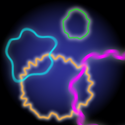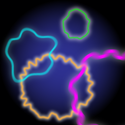A flash in the quark gluon plasma
Gauge/gravity duality, namely, the proposed equivalence between various Yang-Mills and string theories, has the potential to become an important computational tool for particle physics. Although the duality has only been rigorously tested for highly supersymmetric idealizations of quantum chromodynamics, research is aimed at using the duality to make qualitative predictions for experiment.
An important example is the quark-gluon plasma discovered at the Relativistic Heavy Ion Collider (RHIC): strongly coupled Yang-Mills theory is needed to describe this state of matter, but there is a dearth of analytical methods to do so. Theorists are therefore taking advantage of gauge/gravity duality, which allows them to use tractable string theoretic methods to perform computations relevant for the strongly coupled limit of Yang-Mills theories.
In a paper appearing in Physical Review Letters, Jorge Casalderrey-Solana at CERN in Switzerland and Daniel Fernández and David Mateos at the Universitat de Barcelona in Spain utilize the gauge/gravity duality to propose that quarks in the quark-gluon plasma lose energy by producing Cherenkov radiating mesons. This energy loss mechanism is analogous to the radiation produced by high-energy electrons traveling faster than the speed of light in a medium.
Their theoretical picture relies on generic features of the gauge/gravity duality and is expected to be universal to all Yang-Mills theories that possess a gravity duality. The universality of the mechanism makes it potentially relevant for quark-gluon plasma experiments, even though the computations were carried out using idealized (supersymmetric) models. These results are encouraging for theoretical studies of the quark-gluon plasma scheduled for the Large Hadron Collider at CERN. – Abhishek Agarwal





